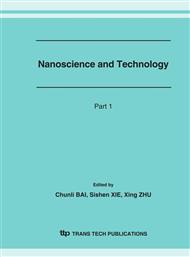p.717
p.721
p.725
p.731
p.735
p.739
p.743
p.747
p.751
The Biological Effect of Iron Oxide and Its Hydrate Nanoparticles
Abstract:
Iron oxide and its hydrate nanoparticles were synthesized by hydrothermal method and confirmed by infrared and SEM (Scanning Electron Microscope) et al. The dimensions of the nanoparticles are about 50-120 nm. The crystalline form of iron oxide nanoparticles is like globosity while its hydrate rod. Amino acids intermingling with the synthesized nanoparticles were crystallized to investigate the space effect of the nanoparticles. The crystalline forms of crystal are different to that of pure amino acid. The positions and width of the nanoparticles’ peaks in the infrared spectrum are changed too. Microscope observation and infrared spectrum results indicated the nanoparticles had changed the internal structure of amino acids crystal. To considerate the toxicity of the synthesized nanoparticles, MTT (3-(4,5-dimethylthiazol 2-yl)-2,5 diphenyltetrazolium bromide) assay was used to determine their cytotoxicity. The OD value (Optical Density) was used to calculated RGR% (Relative Generation Rate) of cells, which determined the grade of cytotoxicity. The RGR of nanoparticles of iron oxide and its hydrate are about 1 to 2, which indicate they have just low toxicity.
Info:
Periodical:
Pages:
735-738
Citation:
Online since:
March 2007
Authors:
Keywords:
Price:
Сopyright:
© 2007 Trans Tech Publications Ltd. All Rights Reserved
Share:
Citation:


